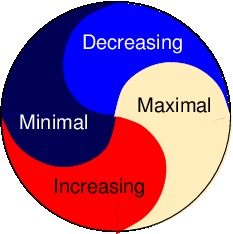Economics of periodic enzyme activities
Main | Pathway models | More models | Article preprint
Can periodic enzyme activities provide a fitness advantage?
 |
In metabolic modelling, it is often taken for granted that cells operate - at least approximately - in steady state. Common calculation methods such as Flux Balance Analysis are entirely based on this assumption. However, wouldn't it be possible that metabolism, at least in some cases, can become more efficient by showing rhythmic, periodic behaviour? Periodic enzyme activities are widely observed in living cells. What is unclear is whether these rhythms serve a biological function - e.g. running different processes at different times, and thus exploiting different biochemical conditions - or whether they just emerge from cellular regulation mechanisms gone wild. |
If enzyme rhythms can improve metabolic efficiency in fact, we may ask: how should these rhythms be coordinated between enzymes, or between larger metabolic pathways? Can we predict optimal adaptations to periodic environments, i.e., the pattern of enzyme amplitudes and phase shifts in a metabolic network? And under what conditions could spontaneous rhythms, without external triggers, become beneficial?
I propose a way to study these questions mathematically. I consider dynamic models of metabolism and study the possible benefits from enzyme rhythms, which can either be adaptations to periodic environments, or arising spontaneously. The theory shows
- how phase shifts between reactant and enzyme levels can affect enzyme efficiency,
- how coordinated enzyme rhythms can redirect fluxes,
- and how they shift metabolic processes to optimal phases in time.
The calculations are applicable to complex metabolic models and shed light on the possible fitness advantages of metabolic cycles.